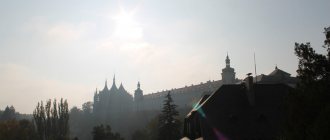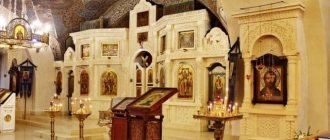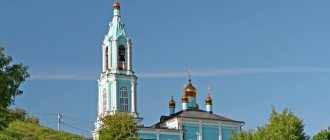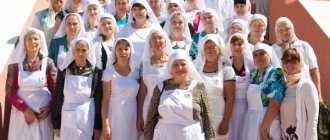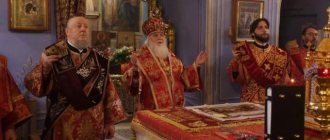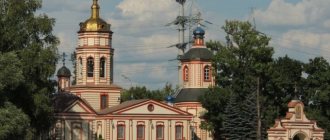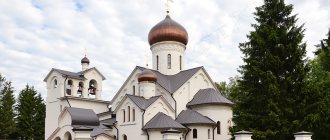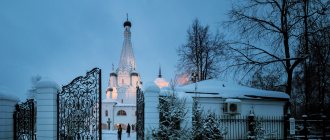Mir
Russia Moscow Church of the Great Martyr Irina in Pokrovskoye (Moscow) Map is loading...
{"format":"leaflet","minzoom":false,"maxzoom":false,"limit":50,"offset":0,"link":"all","sort":[""], "order":[],"headers":"show","mainlabel":"","intro":"","outro":"","searchlabel":"\u2026 \u0441\u043b\u0435\ u0434\u0443\u044e\u0449\u0438\u0435 \u0440\u0435\u0437\u0443\u043b\u044c\u0442\u0430\u0442\u044b","default":"","import-annotation":false,"width ":"auto","height":"350px","centre":{"text":"","title":"""link":"""lat":55.775249999999999772626324556767940521240234375,"lon": 37.6880000000000023874235921539366245269775390625,"icon":""},"title":"","label":"","icon":"","lines":[],"polygons":[],"circles":[ ],"rectangles":[],"copycoords":false,"static":false,"zoom":8,"defzoom":14,"layers":["OpenStreetMap"],"image layers":[] ,"overlays":[],"resizable":false,"fullscreen":true,"scrollwheelzoom":true,"cluster":false,"clustermaxzoom":9,"clusterzoomonclick":true,"clustermaxradius":80, "clusterspiderfy":true,"geojson":"","clicktarget":"","showtitle":true,"hidenamespace":false,"template":"","userparam":"","activeicon": "","pagelabel":false,"ajaxcoordproperty":"","ajaxquery":"","locations":[{"text":"\u003Cb\u003E\u003Ca href=\"/palomnik/%D0% A5%D1%80%D0%B0%D0%BC_%D0%B2%D0%B5%D0%BB%D0%B8%D0%BA%D0%BE%D0%BC%D1%83%D1%87% D0%B5%D0%BD%D0%B8%D1%86%D1%8B_%D0%98%D1%80%D0%B8%D0%BD%D1%8B_%D0%B2_%D0%9F%D0% BE%D0%BA%D1%80%D0%BE%D0%B2%D1%81%D0%BA%D0%BE%D0%BC_(%D0%9C%D0%BE%D1%81%D0%BA %D0%B2%D0%B0)\» title=\»\u0425\u0440\u0430\u043c \u0432\u0435\u043b\u0438\u043a\u043e\u043c\u0443\u0447\u0435\u043d\u0438\u0446\ u044b \u0418\u0440\u0438\u043d\u044b \u0432 \u041f\u043e\u043a\u0440\u043e\u0432\u0441\u043a\u043e\u043c (\u041c\u043e\u0441\ u043a\u0432\u0430)\»\ u003E\u0425\u0440\u0430\u043c \u0432\u0435\u043b\u0438\u043a\u043e\u043c\u0443\u0447\u0435\u043d\u0438\u0446\u044b \u0418\u0 440\u0438\u043d\u044b\u0432\ u041f\u043e\u043a\u0440\u043e\u0432\u0441\u043a\u043e\u043c (\u041c\u043e\u0441\u043a\u0432\u0430)\u003C/a\u003E\u003C/b\u003 E\u003Chr /\u003E \u003Ca href=\"/palomnik/%D0%A1%D0%B2%D0%BE%D0%B9%D1%81%D1%82%D0%B2%D0%BE:%D0%90%D0%BD %D0%BD%D0%BE%D1%82%D0%B0%D1%86%D0%B8%D1%8F\" title=\"\u0421\u0432\u043e\u0439\u0441\u0442\u0432\u043e :\u0410\u043d\u043d\u043e\u0442\u0430\u0446\u0438\u044f\»\u003E\u0410\u043d\u043d\u043e\u0442\u0430\u0446\u0438\u044f\u003C /a\u003E:\u0412 \u0445\u043e\u0434\u0438\u0442 \u0432 \u0441\u043e\u0441\u0442\u0430\u0432 \u0411\u043e\u0433\u043e\u044f\u0432\u043b\u0435 \u043d\u0441\u043a\u043e\u0433 \u043e\u0431\u043b\u0430\u0433\u043e\u0447\u0438\u043d\u0438\u044f \u041c\u043e\u0441\u043a\u043e\u0432\u0441\u043a\u043e\ u0439\u0433\u043e\u0440\u043e \u0434\u0441\u043a\u043e\u0439 \u0435\u043f\u0430\u0440\u0445\u0438\u0438 \u0420\u0443\u0441\u0441\u043a\u043e\u0439 \u041f \u0440\u0430\u0432\u043e\u0441 \u043b\u0430\u0432\u043d\u043e\u0439 \u0426\u0435\u0440\u043a\u0432\u0438. \u0418\u043c\u0435\u0435\u0442 \u0441\u0442\u0430\u0442\u0443\u0441 \u041f\u0430\u0442\u0440\u0438\u0430\u0440\u0448\u0435\ u0433\u043e\u043f\u043e\u0434 \u0432\u043e\u0440\u044c\u044f \u0441 \u041f\u0440\u0435\u0434\u0441\u0442\u0430\u0432\u0438\u0442\u0435\u043b\u044c\u0441\ u0442\u0432\u043e\u043c\u0411 \u0435\u043b\u043e\u0440\u0443\u0441\u0441\u043a\u043e\u0433\u043e\u042d\u043a\u0437\u0430\u0440\u0445\u0430\u0442\u0430 u0432\u0420\u043e\u0441\u0441 \u0438\u0438.","title":"\u0425\u0440\u0430\u043c \u0432\u0435\u043b\u0438\u043a\u043e\u043c\u0443\u0447\u0435\u043d\u0438\u0446\ u044b\u0418 \u0440\u0438\u043d\u044b \u0432 \u041f\u043e\u043a\u0440\u043e\u0432\u0441\u043a\u043e\u043c (\u041c\u043e\u0441\u043a\u0432 \u0430)","link": "","lat":55.775249999999999772626324556767940521240234375,"lon":37.6880000000000023874235921539366245269775390625,"icon":""}],"imageLay ers":[]}
55.775165; 37.688045
Russia, Moscow, Friedrich Engels street, 38
Moscow
Russia
Telephone:
+7 499 261-75-40
Church of the Great Martyr Irina (Trinity Life-Giving) in Pokrovskoye
- Orthodox church in Moscow. It is part of the Epiphany Deanery of the Moscow City Diocese of the Russian Orthodox Church. It has the status of a Patriarchal metochion with the Representation of the Belarusian Exarchate in Russia.
History[edit]
The history of the temple begins in 1635, when a side church was added to the Church of St. Nicholas the Wonderworker. The name of the church is given in honor of St. Great Martyr Irina, patroness of the daughter of Tsar Mikhail Fedorovich and Evdokia Lukyanovna - Irina Mikhailovna. She was born in Pokrovskoye on April 22, 1627 and was the first-born of the royal couple. Irina Mikhailovna’s name day fell on May 18, according to the new style; on the same day there was the patronal feast of the VMC church. Irina.
The German settlement, now the Basmanny district, was a place of settlement for foreigners in Moscow. The area arises along the Pokrovskaya road, which ran from the Frolov Gate of the Kremlin to the northeast to the Vladimir lands. From the 14th century, people began to populate the surrounding area along the Intercession Road and build Orthodox churches. The village of Pokrovskoye appears at this time under the name Rubtsovo, since the Rubtsovs were its first owners. In 1586, this territory came into the possession of Fyodor Nikitich Romanov, and the name of the village eventually became Pokrovskoye.
According to ancient tradition, the side church was additional and independent in relation to the original one, i.e. had its own altar, throne, sacred vessels, liturgical books, iconostasis and its own priest. Church of St. Great Martyr Irene was placed near the church of St. Nicholas the Wonderworker on the land of the church graveyard near the Intercession Road, which is now called Bakuninskaya Street.
Church of St. VMC. Irina was improved primarily thanks to the Romanov royal family. In 1631, the village of Pokrovskoye came into the possession of Irina Mikhailovna. The princess lived here for a long time, delving into all matters and maintaining the splendor of the temples. After a failed attempt to marry Irina Mikhailovna to the Danish Prince Voldemar, who did not want to accept the Orthodox faith, she devotes herself to charitable deeds and prayer for the salvation of her soul. The princess died peacefully at the 52nd year of her life on February 8, 1679 and was buried in the Novospassky Monastery in the Romanov family tomb.
During the period of Peter's reforms, by the will of Peter I, the Nikolskaya and Irininskaya churches were deprived of both grain and monetary support. Church of St. VMC. Irina from this time also becomes a parish church.
In January 1721, the priests and parish people of the Church of St. Nicholas the Wonderworker and the Church of St. VMC. The Irins submitted a petition to Grand Duchess Ekaterina Alekseevna, in which they asked for permission to build both churches in another place due to the dilapidated buildings and cramped conditions. On February 6, 1721, by order of the Highest, a blessed letter was given from Metropolitan Ignatius (Smola) of Sarsk [2] for the construction of the wooden church of St. Nicholas the Wonderworker with the “warm” chapel of St. the apostles Peter and Paul and the wooden side church of St. VMC. Irina. Construction was supposed to be carried out in a new place, but within the territory of the church graveyard.
In the summer months of 1721, the wooden St. Nicholas Church with the chapel of the apostles Peter and Paul was rebuilt almost in the center of the church graveyard. Side wooden church of St. VMC. Irina this time was attached to the St. Nicholas Church on the right noon side, the entrance to it was separate.
In the 60s of the 18th century, it was planned to build a stone St. Nicholas Church with a chapel of the apostles Peter and Paul. The plans were disrupted by unforeseen circumstances: on February 13, 1763, a fire broke out in Pokrovskoye. On February 20, 1763, priests Mikhail and Joseph Ivanov left testimony that in the chapel church of St. VMC. Irina's priest John Vasiliev served with neglect and that this temple caught fire twice in 1762. On February 13, 1763, the fire started from the Irininsky Church and spread to the St. Nicholas - as a result, everything burned to the ground.
After the fire of 1763, construction began on the stone church of St. Nicholas with the chapel of the supreme apostles Peter and Paul. When deciding on the issue of preserving the thrones of two burnt Pokrovsk churches, Empress Ekaterina Alekseevna ordered the Irininsky Church to be placed inside the church of St. Nicholas. She donated 1,000 rubles for the construction of the St. Nicholas Church with the Irininsky chapel, which existed under this name until October 1824, when it was reconsecrated with the blessing of the archbishop. Moscow Philaret (Drozdov) in honor of the Intercession of the Blessed Virgin Mary.
Temple during restoration
The history of the VMC Church does not end here. Irina, since the Irina parish did not accept this course of events. In the summer of 1764, parishioners petitioned Empress Catherine II in St. Petersburg. The petitioners explained the need to build a new church by the growing population in Pokrovskoye and the inability to fit into existing churches. On August 5, 1764, Metropolitan Timofey (Shcherbatsky) of Moscow and Kaluga announced that Catherine II had decided to build a new church in Pokrovskoye. Irininsky parishioners began to “knock on the thresholds” of the patrimonial administration and the Moscow Spiritual Consistory. On October 4, 1764, peasants Ivan Kozmin and Gavrilo Vavilov were called to the estate office, who assured that they were going to build the temple not at public expense, but with donations from parishioners. Under the influence of Catherine II, they decided to name the new wooden church in honor of the Great Martyr Catherine, and to consecrate the chapel in honor of the Great Martyr Irina.
On November 18 and 22, 1764, everyone who wanted to build a new church in Pokrovskoye came to the Moscow Spiritual Consistory. A list of 24 people was compiled who expressed their consent to build a wooden temple at their own expense. In the summer of 1765, land was allocated near Gavrikov Lane to the Yauza, i.e. in the area of modern Irininsky lanes. In the clergy registers, September 29, 1765 is noted as the day of construction of the wooden parish church of the VMC. Catherine with the chapel of the Military Medical Center. Irina. On February 17, 1766, the consecration of the temple took place.
By the end of the 18th century. wooden church of St. VMC. Catherine fell into disrepair and threatened to fall, so St. Mikhail Petrov begins to build a stone church and submits a petition to Metropolitan. Moscow and Kaluga Platon (Levshin) about the abolition of the old wooden church. In July 1792, the main altar was laid, which on April 1, 1800 was consecrated in the name of the Life-Giving Trinity. The temple was built with two chapels to St. VMC. Catherine and St. VMC. Irina. A bell tower was also erected in 1794.
In 1812, the former village of Pokrovskoye experienced another fire associated with the war between Russia and Napoleonic France. The fire, passing along Basmannaya, touched part of Pokrovskaya Street and stopped in front of the Churches of the Intercession of the Blessed Virgin Mary and St. Nicholas the Wonderworker in Pokrovskoye. The Church of the Life-Giving Trinity near the German Market and the market itself suffered greatly at that time.
In 1891, the chapels of the Church of the Life-Giving Trinity (St. Martyr Irene) were expanded and moved to the east in line with the main altar. The consecration of the rebuilt church took place on December 29, 1891.
The temple was richly decorated with ancient shrines. Its iconostasis contained many ancient icons decorated with silver vestments. The iconostasis of the Irininsky chapel housed 14 icons of the 17th century. Among them was a large hagiographic icon of the Great Martyr Irina. The carved Royal Doors housed six 17th-century icons. In the refectory there were icons from the 17th-18th centuries on the walls. More than fifty silver lamps glowed in front of the images.
The interior of the temple was renovated in 1911. Through the diligence of the parishioners and the court supplier N.E. Epanechnikov, a new four-tiered iconostasis was built in the ancient style. For the upper tiers, new icons were painted in the Novgorod style.
Frescoes
The fate of the Church of the Life-Giving Trinity changed dramatically after the revolution of 1917. During the campaign to confiscate church valuables in April 1922, the state removed from the temple more than fourteen pounds of silver vessels, crosses, vestments, lamps, etc. At the same time, Irininskaya Street was renamed Friedrich Engels Street.
The last significant church event of the Church of the Life-Giving Trinity before its closure occurred on October 28, 1923, when Patriarch Tikhon (Belavin) served a liturgy in the temple. Despite this, very soon the temple ceased to fulfill its main task. In the 1920s - 30s, the Voroshilov riflemen club was located in the temple. In 1932, by decision of the Moscow Regional Executive Committee, the temple premises became a dining room. Attempts to defend the shrine were unsuccessful, since the authorities took the position of militant atheists. At the end of the 20th century, the temple premises were used as a warehouse. They destroyed the bell tower and domes, demolished the temple fence, destroyed all the interior decoration, and covered up the church frescoes. The bells from the bell tower were melted down. It is interesting that statues and bas-reliefs were cast from these church bells, which were installed on the facade of the building of the Russian State Library (formerly the Lenin Library) and are there to this day.
Among the famous things of the VMC temple. Irene, noted in 1888 by the Moscow Archaeological Society, was the silver chalice of the chapel church. On its bottom there is an inscription stating that on May 13, 1639, the Great Sovereign Mikhail Fedorovich and the Grand Duchess Evdokia and their children ordered liturgical vessels for the church of the Great Church. Irina. Along with the chalice, a paten, stars and two silver saucers were also donated.
The name of the Great Martyr Irina is firmly entrenched in the history of the German Settlement of Moscow. Near the temple there are the 1st, 2nd and 3rd Irininsky lanes, which have preserved the topography of the land plots of the temple and the church graveyard. Now parishioners of the temple and residents of the area are making efforts to return the original name to Irininskaya Street.
Another interesting fact is related to the fact that the parish folk tradition for centuries retained the name of the VMC for the temple. Irina, despite the construction of the temple in a more remote place and the reconsecration of the temple according to the main altars - first in the name of the Great Martyr Catherine in 1766, and then in the name of the Life-Giving Trinity in 1800. People called the church “Irina the Martyr in Pokrovskoye.” A short name was also used - Irininsky Temple. When a historical turning point came in 1992, and the temple was returned to the Russian Orthodox Church, it was decided to preserve the original historical name in honor of the Holy Great Martyr Irene.
"Through the diligence of the royal family..."
On May 18, 2021, in the Moscow Church of the Holy Great Martyr Irina in Pokrovsky, which on October 10, 2013, with the blessing of His Holiness Patriarch Kirill of Moscow and All Rus', officially became the Patriarchal Compound with the Representation of the Belarusian Exarchate in Russia, its rector, His Eminence Dimitri, Archbishop of Vitebsk and Orsha, served a festive service Divine Liturgy, and the night before an all-night vigil in the concelebration of the clergy of the temple - hieromonks Dimitry (Tyshchenko), Seraphim (Pavlyuchenko), Misail (Doylin) and Archpriest John Kaled.
The diaconal rank was headed by Deacon Evgeniy Makarkvich. Liturgical chants were performed by the wonderful folk choir of the Church of St. Irina, led by regent N.P. Sirikyan.
On the day of the patronal feast in the church of the VMC. Irinas in Pokrovsky, which has been a decoration of the Basmanny district of Moscow for almost four centuries, Irinas come from all over the city. Almost all of them try to confess and partake of the Holy Mysteries of Christ on the day of remembrance of their heavenly patroness. But not everyone knows that the history of the church is closely connected with the names of representatives of the House of Romanov. On July 17-18, 2021, we will celebrate the 100th anniversary of the death of the holy royal martyrs - the family of the last Russian Emperor Nicholas II. This tragic date, no doubt, will be celebrated in the Irininsky Church.
It must be said that the Church of the Holy Great Martyr Irene was improved primarily thanks to the Romanov royal family. Among the famous things of the temple, noted in 1888 by the Moscow Archaeological Society, was, for example, a silver chalice, on the bottom of which there was an inscription stating that on May 13, 1639, the Great Sovereign Mikhail Fedorovich and the Grand Duchess Evdokia and their children ordered liturgical vessels for the church of the Great Church. Irina. Along with the chalice, a paten, stars and two silver saucers were also donated.
On April 22, 1627, Tsar Mikhail Fedorovich and Evdokia Lukyanovna gave birth to their first child, Irina Mikhailovna. In 1631, the village of Pokrovskoye came into her possession, where in 1635 a side church in honor of St. Great Martyr Irina - patroness of Irina Mikhailovna. She celebrated her name day on May 18 (new style) - the patronal feast of the VMC Church. Irina. Parents tried to marry Irina Mikhailovna to the Danish Prince Voldemar, but he did not want to accept the Orthodox faith, and then the princess, for the sake of saving her soul, devoted herself to charitable deeds, prayer and maintaining the splendor of churches. On February 8, 1679, she died at the age of 52 and was buried in the Novospassky Monastery in the Romanov family tomb.
And on May 6 (19 New Style), 1868, on the day of the holy righteous Job the Long-Suffering, a boy was born into the Romanov family, who, by the providence of God, was destined to become the last Russian Emperor Nicholas II.
Nikolai Malinkin , celebrated his 70th birthday . His grandmother was also a parishioner of this temple. Being a believer from early childhood and seeing the abomination of desolation that reigned in the once beautiful temple, Nikolai Anatolyevich promised himself to do everything possible for its revival, which he is doing to the best of his ability to this day.
And the restoration of the Irininsky Church still requires a lot of effort and money, because only during the campaign to confiscate church valuables in April 1922, the state removed more than fourteen pounds of silver vessels, crosses, vestments, and lamps from the temple. It was then that Irininskaya Street was renamed Friedrich Engels Street. Now parishioners of the temple and residents of the area are making every effort to return Irininskaya Street to its original name.
On October 28, 1923, Patriarch Tikhon (Belavin) celebrated the last Divine Liturgy in the church.
In the 1920-1930s, a club of Voroshilov shooters worked in the temple. In 1932, by decision of the Moscow Regional Executive Committee, the temple premises were used as a dining room, and at the end of the 20th century - as a warehouse. The temple fence was demolished, all the interior decoration was destroyed, the bell tower was destroyed, and the bells were melted down. Statues and bas-reliefs were cast from them, which are still on the facade of the building of the Russian State Library (formerly the Lenin Library). According to Nikolai Malinkin, only the frescoes that were supposed to be knocked down were lucky, but one God-fearing man did not dare to carry out the order: he did not knock down, but whitewashed the frescoes. Now, under the hands of restorers, they are finding a new life, like the entire Irininsky Temple.
His Eminence Dimitri, Archbishop of Vitebsk and Orsha, congratulating the parishioners of the church on the patronal holiday, expressed the hope that every year more and more Irin will come to her church not only on May 18, but throughout the year. The Bishop invites us all to visit the Church of St. Irene and on Trinity Sunday, because this is another patronal feast of the temple, where there is a Sunday school for children and adults and a wonderful folk choir, the choir director of which received a well-deserved award on May 18, 2021 from the hands of the rector of the temple.
Although work on the revival of the temple is still in progress, it has become easy to breathe in it. Parishioners believe that the Irininskaya Church will soon appear before us in all its glory, once again reborn from the ashes, like a Phoenix bird.
On February 13, 1763, as a result of a fire that started from the Irininskaya Church and engulfed the Church of St. Nicholas, everything burned to the ground. In 1812, the former village of Pokrovskoye experienced another fire, which, passing along Basmannaya, affected part of Pokrovskaya Street and stopped in front of the Churches of the Intercession of the Blessed Virgin Mary and St. Nicholas the Wonderworker in Pokrovskoye. At that time, the Church of the Life-Giving Trinity near the German Market and the market itself suffered greatly. It is interesting that folk tradition has retained the name of the VMC for the temple for centuries. Irina, despite the reconsecration of the temple according to the main altars - first in the name of the Great Martyr Catherine in 1766, and then in the name of the Life-Giving Trinity in 1800. People called the church either “Irina the Martyr in Pokrovskoye”, or briefly “Irininsky Temple”.
The name of the Great Martyr Irina is firmly entrenched in the history of the German Settlement of Moscow. Near the temple there are the 1st, 2nd and 3rd Irininsky lanes, which have preserved the topography of the land plots of the temple and the church graveyard. When the temple was returned to the Russian Orthodox Church in 1992, it was decided to retain its original historical name in honor of the Holy Great Martyr Irene.
Holy Great Martyr Irina, pray to God for us!
Photo by the author, from the website of the Church of St. VMC. Irina and from free sources
Current state[edit]
The temple preserves pearls of ancient Russian painting. Let's look at some of them.
Interior decoration
Regarding the picturesque paintings in the interior of the temple, the Conclusion of the Office of State Control over the Protection and Use of Historical and Cultural Monuments established that:
“Initially, the temple was painted soon after construction, but already in 1813 the painting was renewed. Significant painting work was carried out in the middle and at the end of the 19th century. It was stated that there were paintings in the temple that were done at a high professional level and are of artistic value. The idea of the dignity of temple painting was confirmed by probe openings commissioned by the temple by the artist-restorer V. Pankratov, as well as the expert opinion of the candidate of art history, artist-restorer S. Filatov.
The wall paintings of each volume of the temple reflect the evolution of the style of church paintings throughout the 19th century. Fragments of the earliest painting, dating from the first half of the 19th century, have been preserved in the Trinity Church, which includes the composition “Old Testament Trinity” /Hospitality of Abraham/, images of St. Helena and other martyrs, towels and trims in the lower parts, as well as fragments of ornament on the vault . The most interesting is the painting of the refectory of the Catherine Church - the composition “The Last Supper” on the western slope of the vault. The painting was done in oil on a gilded background in the Palekh manner, imitating ancient Russian painting.
With an orientation towards the “academic style” of painting based on the models of the Cathedral of Christ the Savior, the most recent painting was done in the altar of the Church of St. Irina. Taking into account the artistic merits of the revealed painting, it should be noted that the significance of the painting is not limited to the decorative and artistic function, but contains a spiritual and symbolic program in plots and scenes of sacred history, embodying the idea of the temple as an image of the universe. The investigations carried out confirmed that a picturesque ensemble has been preserved in the temple, which must be restored.” Presumably the authorship of part of the painting of the temple may belong to V.M. Vasnetsov and M.V. Nesterov.
